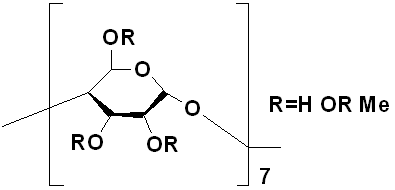Shopping Cart
- Remove All
 Your shopping cart is currently empty
Your shopping cart is currently empty

Methyl-β-cyclodextrin (Methyl-beta-cyclodextrin) is a macrocyclic compound utilized as a solubilizer for hydrophobic substances in biological studies, and serves as a lipid raft inhibitor with cholesterol-lowering and potential antitumor activities.

| Pack Size | Price | Availability | Quantity |
|---|---|---|---|
| 500 mg | $33 | In Stock | |
| 1 g | $42 | In Stock |
| Description | Methyl-β-cyclodextrin (Methyl-beta-cyclodextrin) is a macrocyclic compound utilized as a solubilizer for hydrophobic substances in biological studies, and serves as a lipid raft inhibitor with cholesterol-lowering and potential antitumor activities. |
| Targets&IC50 | PEL:3.33-4.23 mM. |
| In vitro | METHODS: Five primary exudative lymphoma (PEL) cell lines, BCBL-1, BC-1, BC-3, TY-1, and GTO, were treated with Methyl-β-cyclodextrin (0-10 mM) for 24 h, and cell viability was measured by MTT assay. RESULTS: Methyl-β-cyclodextrin dose-dependently inhibited the growth of PEL cells with IC50 between 3.33-4.23 mM. [1] METHODS: Chicken hepatocellular carcinoma cells, LMH, were treated with Methyl-β-cyclodextrin (10 mM) for 1 h, then cholesterol (50 µg/mL) was added at different time points before, during, and after infection with FAdV-4, and the expression levels of the target proteins were detected by Western Blot. RESULTS: When LMH cells were pretreated with increasing concentrations of Methyl-β-cyclodextrin prior to infection, penton protein levels decreased in a dose-dependent manner. [2] |
| In vivo | METHODS: To test the antitumor activity in vivo, Methyl-β-cyclodextrin (500 mg/kg) was intraperitoneally injected into NRJ mice bearing PEL tumor BCBL-1 once a day for twenty-one days. RESULTS: Methyl-β-cyclodextrin significantly inhibited the growth and invasion of PEL cells without significant adverse effects. [1] METHODS: To investigate the modulatory effects on collagen, Methyl-β-cyclodextrin (1.25-5.0 mg/mouse) was intradermally injected into the SKH1 mouse twice a week for two months. RESULTS: Methyl-β-cyclodextrin showed potent COL I up-regulatory activity resulting in increased skin thickness. [3] |
| Kinase Assay | PEL cells are incubated in triplicate in a 96-well microculture plate in the presence of different concentrations of methyl-β-cyclodextrin (0-10 mM) in a final volume of 0.1 mL for 24 h at 37°C. Subsequently, MTT (0.5 mg/mL final concentration) is added to each well. After 3 h of additional incubation, 100 μL of a 0.04 N HCl is added to dissolve the crystals. Absorption values at 570 nm are determined. |
| Cell Research | PEL cells are incubated in triplicate in a 96-well microculture plate in the presence of different concentrations of methyl-β-cyclodextrin (0-10 mM) in a final volume of 0.1 mL for 24 h at 37°C. Subsequently, MTT (0.5 mg/mL final concentration) is added to each well. After 3 h of additional incubation, 100 μL of a 0.04 N HCl is added to dissolve the crystals. Absorption values at 570 nm are determined[1]. |
| Alias | Methyl-beta-cyclodextrin, beta-Cyclodextrin methyl ethers |
| Molecular Weight | 1310(Average) |
| Formula | C54H94O35 |
| Cas No. | 128446-36-6 |
| Smiles | COCC1OC2OC3C(COC)OC(OC4C(COC)OC(OC5C(COC)OC(OC6C(COC)OC(OC7C(COC)OC(OC8C(COC)OC(OC1C(O)C2OC)C(OC)C8O)C(OC)C7O)C(OC)C6O)C(OC)C5O)C(OC)C4O)C(OC)C3O |
| Relative Density. | 1.4 g/cm3 |
| Storage | Powder: -20°C for 3 years | In solvent: -80°C for 1 year | Shipping with blue ice. |
| Solubility Information | DMSO: 55 mg/mL, Sonication is recommended. |

Copyright © 2015-2025 TargetMol Chemicals Inc. All Rights Reserved.